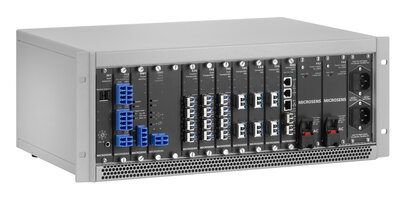
Data centre interconnect at Barmenia Versicherungen: Thanks to wavelength multiplexing, data is on the safe side
Right across Wuppertal Barmenia is one of Germany's biggest independent insurance groups. Its product range extends from health and life insurance to accident and motor vehicle insurance through to liability and property insurance. The Wuppertal based company currently employs over 3400 staff. Enquiries from and information on over a million policyholders are processed securely and promptly in two redundantly configured data centres. Barmenia additionally uses a third data centre for reliable and durable storage of data. For security reasons, this is located several kilometres away from the company's headquarters and is connected via two leased fiber-optic links running right across Wuppertal.
Low latency, high flexibility, permanent availability
Barmenia uses wavelength multiplexers to meet the demand for bandwidth over this distance. The parallel transfer of several wavelengths over a fiber pair makes it possible to reach transmission capacities of several hundred Gbps without the necessity of installing additional fiber-optic lines. However, the previous systems were outdated and had to be replaced. MICROSENS was among the providers of a new solution. With its MSP100 Optical Transport Platform, the company has a modular system at its disposal, which is especially tailored for use with corporate customers. Particularly its easy handling while ensuring very high flexibility convinced Dr. Uwe Fasting, head of the Infrastructure and Architecture Management department at Barmenia: “We can cover all our protocols with one transponder card without significantly raising the transit time of the signal. Demonstration of the system in laboratory operation was really convincing”. The Barmenia team saw the proximity to Zech Sicherheitstechnik – the company that was to put the components into operation – as a further advantage. Moreover, the MSP 1000 fulfils a further important criterion – the system has a redundant power supply, yet it still requires less current than the model previously used. This fact plays a crucial role for Barmenia in terms of sustainability, as well as cost saving.

Securely into the Internet
A further aspect had to be considered in the implementation of the new WDM (Wavelength Division Multiplexing) technology: Roughly 50% of data traffic with the Internet is via fiber-optic lines between the data centres on the company site and the remote data centre. Now considering the high degree of digitalisation and the high Internet affinity of insurance customers, the importance of the connection soon becomes apparent. Having had bad experience in the past with damaged optical fibers caused by construction work, now the MICROSENS Optical Power Monitor is additionally used. This compact device continuously monitors the light intensity on the optical fibers and immediately detects the slightest changes. Both gradual deteriorations of the optical fibers, as well as damage to the optical fibers, can be identified, localised and eliminated without delay. Downtimes are minimised and the insurance company obtains an efficient means of checking the service provider’s adherence with SLAs.
Despite the absence of trials - an unqualified success
A challenge in implementation was presented by the immediate live operation of the systems. While a connection is put into operation on a trial basis in most cases, the MICROSENS devices had to be commissioned quickly, reliably and without further tests in the productive environment. The experts from Zech Sicherheitstechnik removed the old systems, replaced them with the MSP 1000 platform, and put it into operation, as Dr. Fasting explains: "The support from both Zech Sicherheitstechnik and from MICROSENS was really outstanding overall. The switchover took place in a very short time and absolutely smoothly. A great relief for us”.
Close proximity as an additional bonus
Barmenia Versicherungen operate their IT structure largely single-handedly. Should problems occur in operation, the team attaches a great deal of importance to fast and reliable support from the manufacturer. This is where the advantages of close proximity to the provider come into their own, as Dr. Fasting explains: “As early as in the preparation phase, we were amazed with the fast reaction and the competent support from the MICROSENS team. We are certain we will receive excellent support at all times”.
About MICROSENS
Transmitting information via fiber optic connections offers numerous benefits. MICROSENS GmbH & Co. KG recognised this very early on. As one of the pioneers, the company has developed and produced high-performance communications and transmission systems in Germany since 1993. Individually matched to the demands of diverse usage areas and embedded in comprehensive concepts for individual sectors. But, above all, close to the customer. Technical challenges from customer projects are incorporated directly into product development. This way, IP-based automation solutions are created for modern buildings, cost-efficient network concepts for the office and workspace, robust and fail-safe solutions for industrial environments, optical transport systems future-oriented wide area networks and efficient coupling of sites and computer centres.












